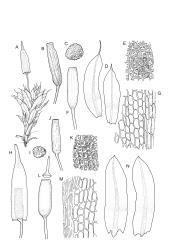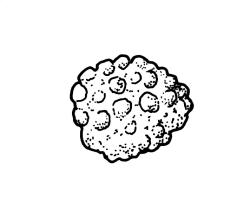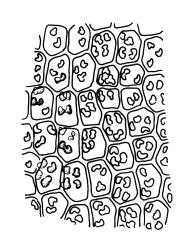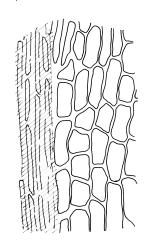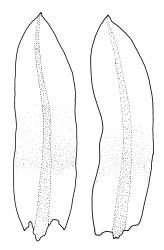- = Encalypta novae-zealandiae Colenso, Trans. & Proc. New Zealand Inst. 16: 348 (1884)
Plants dull brown-green to dark yellow-green. Stems mostly 5–10(–20) mm. Leaves oblong to lingulate, rather abruptly narrowed above to a broadly acute and muticous apex, inrolled when dry, erect-spreading when moist, broadly V-shaped in cross-section, with margins crenulate and papillose above, plane or weakly recurved, 3.0–3.5 × 0.9–1.0 mm; upper laminal cells short-oblong or rounded-quadrate, bulging, each with 2–4 tall and mostly branched papillae, mostly 12–15 × 10–12 µm, becoming shorter and ± oblate near margins, grading into the cells of the lower lamina; cells of lower lamina elongate-oblong, smooth, mostly 45–75 µm, with thin longitudinal walls and thickened and yellow-orange transverse walls (especially near base of costa); cells of the lower margin narrower and more elongate, forming a border 5–6 cells wide and fading at the junction with the papillose laminal cells. Costa stout and prominent abaxially, dull brown to dull yellow, ± lustrous in dry material, subpercurrent, with cell ends weakly or strongly projecting abaxially above, in cross-section semi-circular on abaxial surface, with a single layer of guide cells, 2 layers of large adaxial cells (including the papillose cells on adaxial surface), and a large abaxial stereid band.
Gonioautoicous. Perichaetia with leaves scarcely differentiated, often overtopped by innovations. Perigonia located immediately below perichaetia, c. 1 mm, the bracts ovate and obtuse, surrounding few antheridia and filiform paraphyses. Setae 4–5(–10) mm, yellow, smooth, straight, not twisted; capsules as per genus, weakly striate-wrinkled when dry, gold-brown, weakly constricted and red at mouth, 2.6–3.0 × c. 0.75 mm; exothecial cells short- to elongate-oblong, thin-walled; stomata few, superficial, apparently scattered in lower urn (occurring to c. ¼ above base); annulus lacking; operculum narrowly long-rostrate from a conic base, straight, 0.9–1.0(–1.3) mm. Peristome nil. Spores ± reniform, coarsely bullate-insulate on distal surface, often with a weak trilete scar, often persisting as tetrads in N.Z. material, 27–39 µm. Calyptra long-mitrate, completely enclosing the capsule, weakly lobed at base, weakly scabrose or smooth near tip, 4.5–6 mm.
Scott & Stone 1976, pl. 41; Horton 1994, fig 315; Smith 2004, fig. 162, 7–10; Seppelt et al. 2013, pl. 5.
NI: Hawke’s Bay, Wellington (Taihape, Ruahine Range); SI: Nelson (Arthur Range, Owen Range), Marlborough, Canterbury, Otago.
Bipolar or anomalous. Although there are numerous collections from Hawke’s Bay L.D., I have seen none more recent than 1948. However, there is no reason to believe this species would not still occur there. Tasmania*, mainland Australia*, widespread in northern hemisphere. Recorded from New Guinea and Africa by Smith (2004).
On cation-rich and calcareous rock and derived soil. Growing on limestone, greywacke, basalt, schist, sandstone, and rarely on concrete. A large number of collections from throughout Otago (mostly by W. Martin) indicate it to be widespread throughout the eastern parts of this L.D. and suggest that it is common in drier tussock and shrubland. Herbarium records also include such habitats (from Otago L.D.) as a "sandy bank at lakeside" (Lake Wānaka, J.T. Linzey 334, CHR 613290) and "damp rock faces" (Glendhu Bluff, Lake Wānaka, P. Child, s.n., CHR 422932).
The elevational range on NI is poorly documented. Occurring at 1200–1300 m (at Ōhutu Ridge, Ruahine Range) and apparently at much lower elevations in the Hawke’s Bay region. On SI it ranges from c. 60 m (near Berwick, Otago L.D.) to at least 1650 m (Mt Arthur, Nelson L.D.) and possibly to as high as c. 2400 m (Inland Kaikōura Range, Marlborough L.D.). In addition to Encalypta rhaptocarpa, common associates include Bryoerythrophyllum recurvirostrum, Didymodon torquatus, Distichium capillaceum, Syntrichia anderssonii, S. antarctica, S. serrata, and Weissia controversa, as well as (less commonly) such species as Ceratodon purpureus, Fissidens megalotis, and Grimmia pulvinata. The last three species seem to co-occur with E. vulgaris when it grows on basalt or greywacke.
When dry the plants have a dull, ± brown-green colour. The lingulate leaves are strongly inrolled at their apices and the stout, dull brown, and weakly lustrous costae are prominent abaxially. In larger plants the leaves can be weakly spirally twisted around the stem as well as inrolled. If collected in a sterile condition the presence of the thickened and pigmented transverse walls of the basal cells, together with the nature of the leaf apex, permit placement. However, because of its gonioautoicous (perigonia on small branches immediately below the perichaetium) sexuality, this species is nearly always collected with capsules.
N.Z. material only rarely has setae exceeding 5-7 mm. One aberrant collection (from Avon Valley, Marlborough) has a few sporophytes with setae c. 10 mm. The setae in this collection slightly exceed the range given by Horton (1994) for this species in Mexico.
Some emphasis was given by early authors to the purportedly smooth apex of the calyptra in N.Z. material (see Dixon 1926, p. 153); this feature was part of the reason that Colenso described E. novae-zealandiae. However, both smooth and finely scabrose calyptrae occur throughout the N.Z. range of this species and both can sometimes be observed in single collections (e.g., G. Brownlie 625, Porter River, Canterbury, CHR 427843). Diana Horton (in herb. CHR) confirmed N.Z. material as E. vulgaris and I agree with Dixon (1926) that little purpose would be served by taxonomic segregation of Australasian material from northern hemisphere material. Dixon (1926) also discussed the variability of the vegetative leaf apices in N.Z. material.
The Tasmanian names E. australis Mitt. and E. tasmanica Müll.Hal. & Hampe have been applied to N.Z. material. Dixon (1926) placed both these names in the synonymy of E. vulgaris and there is no reason to question his decisions here. Dalton et al. (1991) endorsed the synonymy of E. australis Mitt., but did not comment on E. tasmanica.




